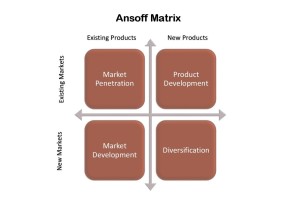Ansoff Matrix is a marketing tool developed by H Igor Ansoff which can be used to assist a business in planning its marketing strategy.
Marketing using the Ansoff Matrix
The Ansoff’s Matrix focuses on products, whether the products are new or already existing and whether the market is new or already existing and considers that there are four possible marketing growth strategies.
Market Penetration, Product Development, Market Development and Diversification.

Market Penetration
When a product is already in existence and there is an existing market a business may wish to consider Market Penetration as an appropriate growth strategy. This is when a business promotes or pushes an existing product or service further into an already existing market with the aim to increase their market share.
An increased market share is usually achieved through selling more of their products or services to existing customers or by increasing the customer base within the existing market. The business will usually look to do this without changing the product, or at least without making any drastic changes.
The success of this strategy will rely one or more of the following:
Marketing, which will require the business to increase its advertising spend.
A change to pricing policies, often a decrease in price will be needed to attract new customers or encouraging existing customers to increase spend buying more of the product.
These are some of the smaller scale options. In some circumstances a business may resort to the acquisition of a rival in the market. This can be a successful strategy as it removes a direct competitor and it hands the business a new customer base.
Market Penetration is often seen as one of the least risky strategies, as it is focusing on both a product and market that is familiar, it simply builds on something already proven.
Product Development
Product Development is concerned with the introduction of new products into an already established market. Product Development does not have to involve an entirely new product it can be the introduction of a modified product into the market or extending an already successful range. By using the Ansoff Matrix to develop or modify an existing product, you can appeal to the existing customer base.
Take a look at the technology industry which is constantly evolving, just because a product is a success the company will not stop there, very often you will see an upgraded or latest version hit the market in a relatively short time from the initial success.
A business looking to adopt this strategy can approach this through investment through research and development, if funding proved difficult the business may join forces with another organisation reducing the cost, the downside, this would also reduce potential profit.
An alternative approach for a business to expand its product range can be through the acquisition of a product developed by another business and branding or the acquisition if distribution rights.
Market Development
The next strategy to consider is Market Development. This is usually expanding the target market of an existing product or expanding its availability. For this to be appropriate you would need to have a product that is already successful in its primary market place, for instance through being unique so there is not a direct competitor within the new market.
This can be through expanding distribution geographically, depending on the business size this could be different areas of the country or opening up the availability of your product to the overseas market.
This approach can be costly as it can involve setting up overseas branches or cross border distribution. An ecommerce solution is an example of this, it opens up the availability of a product to many markets. This strategy takes a business into the unknown so is considered riskier than some of the other approaches.
Diversification
This strategy involves a company increasing its market presence through new developments, this can involve both product and market development.
Diversification can be related diversification, when the products are related for instance in the same field but serve different purposes. A business may see success from this with potential for synergy between new and original products, for instance the products may complement one another.
Unrelated diversification refers to the option to diversify into a totally unrelated business area.
Diversification can be risky if not approached carefully as the business may have little experience in the new market or with the new product. It is likely to require high levels of investment. Also in fast paced markets, such as technology, the economics of the diversification required to create a financially viable outcome may exceed the development costs of a novel product or offering.
The business will need to fully appraise the potential risk and reward if they are considering embarking on a diversification strategy. Use the Ansoff Matrix along with other strategic tools including the Mendelow’s Matrix and Porter’s 5 Forces.